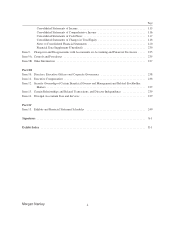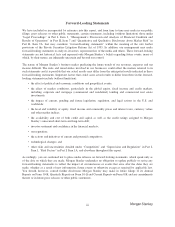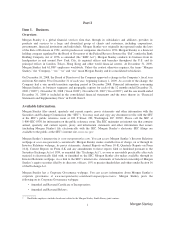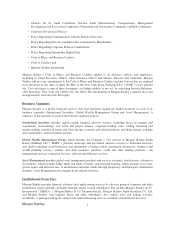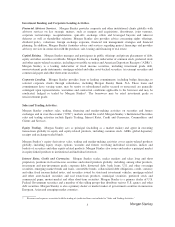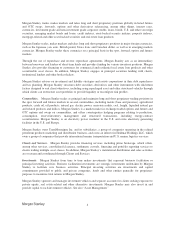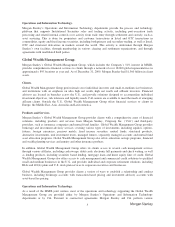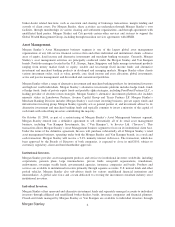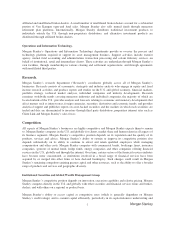Morgan Stanley 2009 Annual Report Download - page 12
Download and view the complete annual report
Please find page 12 of the 2009 Morgan Stanley annual report below. You can navigate through the pages in the report by either clicking on the pages listed below, or by using the keyword search tool below to find specific information within the annual report.
sales, trading, financing and market-making activities, also affects its competitive position. Corporate clients may
request that Morgan Stanley provide loans or lending commitments in connection with certain investment
banking activities.
It is possible that competition may become even more intense as Morgan Stanley continues to compete with
financial institutions that may be larger, or better capitalized, or may have a stronger local presence and longer
operating history in certain areas. Many of these firms have greater capital than Morgan Stanley and have the
ability to offer a wide range of products and services that may enhance their competitive position and could result
in pricing pressure in our businesses. The complementary trends in the financial services industry of
consolidation and globalization present, among other things, technological, risk management, regulatory and
other infrastructure challenges that require effective resource allocation in order for Morgan Stanley to remain
competitive.
Morgan Stanley has experienced intense price competition in some of its businesses in recent years. In particular,
the ability to execute securities trades electronically on exchanges and through other automated trading markets
has increased the pressure on trading commissions. The trend toward direct access to automated, electronic
markets will likely continue. It is possible that Morgan Stanley will experience competitive pressures in these
and other areas in the future as some of its competitors may seek to obtain market share by reducing prices.
Asset Management.
Competition in the asset management industry is affected by several factors, including Morgan Stanley’s
reputation, investment objectives, quality of investment professionals, performance of investment products
relative to peers and an appropriate benchmark index, advertising and sales promotion efforts, fee levels, the
effectiveness of and access to distribution channels, and the types and quality of products offered. Morgan
Stanley’s alternative investment products, such as private equity funds, real estate and hedge funds, compete with
similar products offered by both alternative and traditional asset managers.
Supervision and Regulation.
As a major financial services firm, Morgan Stanley is subject to extensive regulation by U.S. federal and state
regulatory agencies and securities exchanges and by regulators and exchanges in each of the major markets
where it operates. Moreover, in response to the financial crisis, legislators and regulators, both in the U.S. and
worldwide, are currently considering a wide range of proposals that, if enacted, could result in major changes to
the way Morgan Stanley is regulated and conducts its business.
Regulatory Outlook.
It is likely that the year 2010 and subsequent years will see material changes in the way that major financial
institutions are regulated both in the U.S. and worldwide. The reforms being discussed include several that
contemplate comprehensive restructuring of the regulation of the financial services industry. Enactment of such
measures likely would lead to stricter regulation of financial institutions generally, and heightened prudential
requirements for systemically important firms in particular. Such measures could include taxation of financial
transactions, liabilities and employee compensation as well as reforms of the OTC derivatives markets, such as
mandated exchange trading and clearing, position limits, margin, capital and registration requirements. Other
changes under discussion in the U.S. legislative arena include: breaking up firms that are considered “too big to
fail” or mandating certain barriers between their activities in order to allow for an orderly resolution of failing
financial institutions; curtailing the ability of firms that own Federal Deposit Insurance Corporation (“FDIC”)-
insured institutions to also engage in private equity, hedge fund and proprietary trading activities; requiring firms
to maintain plans for their dissolution; requiring the financial industry to pay into a fund designed to help unwind
failing firms; providing regulators with new means of limiting activities of financial firms; regulating
8



